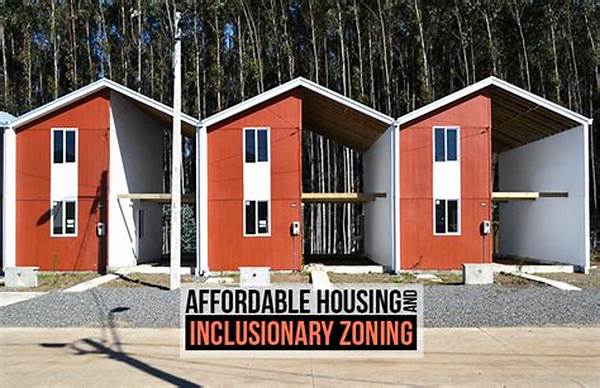It was a breezy Tuesday evening in Cloverfield—the kind of night where the stars play peekaboo behind drifting clouds. A group of friends gathered under the fairy lights on Lucy’s back porch, diving into their usual chatter about life, dreams, and the next big thing. But this time, the conversation took a twist. Marco, with his eyes twinkling with excitement and a hint of mystery, leaned in and exclaimed, “Guys, you won’t believe what I just stumbled upon—something called inclusionary zoning for affordable housing. Trust me, it’s a game changer!”
Read Now : Budget-friendly Townhouse Upkeep Options
The Magic of Inclusionary Zoning
Intrigued, everyone leaned in closer. Marco explained that inclusionary zoning is all about making cities a little fairer, a bit more balanced. You know, like inclusivity with a real estate twist. Cities that jump on this bandwagon require developers to include a certain percentage of affordable units in new housing projects. For folks struggling with sky-high rents, it’s like finding a golden ticket. Picture living in a vibrant neighborhood where you’re not just scraping by but thriving, surrounded by posh cafes and trendy spots. That’s the dream inclusionary zoning for affordable housing aims to bring within reach. Marcos’ excitement about the topic was contagious, and soon everyone was buzzing with ideas, hope, and a newfound appreciation for housing policies that didn’t leave regular folks out of the equation. Suddenly, the once-distant vision of a community where everyone mingles—irrespective of their wallet size—didn’t seem so far-fetched.
Breaking Down the Jargon
1. Easy-Peasy Policy: Inclusionary zoning for affordable housing means developers gotta include some cheaper pads in new builds. No biggie, just mixing things up!
2. Affordable Cribs: Imagine snagging a sweet deal on rent in a swanky neighborhood. That’s inclusionary zoning magic right there.
3. Mix-n-Match Living: It’s like a melting pot for housing—wealthy and not-so-wealthy living it up side by side.
4. Rent Relief: Finally, not just pie in the sky so folks ain’t living paycheck to paycheck.
5. Leveling the Playing Field: It’s about giving everyone a fair shot, whatever your bank balance.
Inclusionary Zoning: The Urban Revolution
Fast forward to a downtown cafe, with Latte Lenny sharing Marco’s revelation during the morning grind. And as it turned out, inclusionary zoning for affordable housing was part of a bigger picture—a radical urban revamp. Cities shook off their outdated housing models, recognizing that diverse communities were stronger communities. For many, this inclusivity brought a newfound sense of dignity. Suddenly, first-time homebuyers and families could envision their futures with roofs over their heads that didn’t break the bank. It’s such a no-brainer, right?
Read Now : Budget-friendly Homes With Minimal Dues
As the idea gained traction, cities brimmed with energy as folks from different backgrounds mingled effortlessly. Where once housing was a fortress of exclusivity, inclusionary zoning for affordable housing planted seeds of hope. Conversations about thriving, not just surviving, filled the airwaves, and soon enough, the idea was more than just a trendy buzzword; it became a movement. To be part of a city that champions everyone—not just the elite—sounded like home to a lot of people. This was the heart and soul of inclusionary zoning for affordable housing: leveling the playing field one building at a time.
Zoning in on Solutions
At its core, inclusionary zoning for affordable housing is a heartening idea, one that comes alive through urban planners sketching dreams on blueprints and residents sharing stories at neighborhood gatherings. Taco Tuesdays morphed into brainstorming sessions as communities pitched in thoughts to maximize new opportunities. Folks who once felt sidelined now had a say. It’s all about rallying together and creating inclusive spaces for everyone to thrive. Before long, towns that embraced this novel idea saw neighborhoods flourishing. Businesses boomed, kids dashed around safely in spruced-up parks, and there was a renewed pride in local communities. Neighbors, once strangers, waved from across white-picket fences. These vibrant areas aren’t just photos on postcards, they’re real pockets of progress.
Inclusionary zoning for affordable housing wasn’t just a concept or a law. It was an act of unity, a grand experiment. Cities weren’t merely concentrated pockets of wealth—they became melting pots of cultural vibrance and shared experiences. With each new housing project, a new story unfolded, a fresh chance for everyday people to create legacies and steam full ahead into a future where dreams had room to grow.
Embracing Change
Marco, now an ardent advocate, rounded up his friends. They decided to attend their first town meeting to share what they’d learned. Fueled by tacos and dreams, they carried the torch for inclusionary zoning for affordable housing, determined to become catalysts for change. Yet, for all their passion, they knew the journey was just starting. Conversations rippled through the community, and slowly but surely, the tide began to turn. Peeking into the future, thanks to efforts like these, nobody’s left behind. In time, inclusionary zoning for affordable housing isn’t simply words on paper; it’s a movement transforming skylines, and with it, bringing back the essence of what housing should be—home for all.
